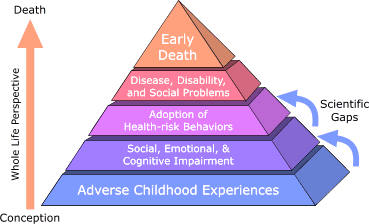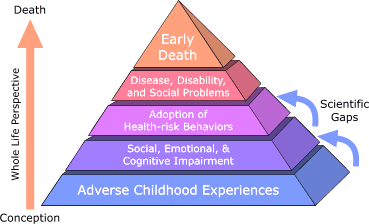 The Adult Attachment Interview (AAI) study since 1994 shows that 50% of Americans have some degree of failed attachment in childhood. These are rigorous psychiatric studies of the general public which have nothing to do with “addicts.” It’s not just about “them.” [FN1]
The Adult Attachment Interview (AAI) study since 1994 shows that 50% of Americans have some degree of failed attachment in childhood. These are rigorous psychiatric studies of the general public which have nothing to do with “addicts.” It’s not just about “them.” [FN1]
It’s about “the hole in me” inside half of us. Secure attachment is necessary for the neurons in a baby’s brain to develop. “The hole” is caused by any problematic bonding with the mother. That means “parts of my brain are dark” — the neurons just don’t fire. (Above left: normal 3 year old. Right: major attachment disorder)
No coincidence, 50% of Americans also abuse not only alcohol and drugs (including prescriptions) but also tobacco, food, gambling, internet porn, sex… Those of us who’d never “use” anything, often become work-aholics. All these, abused, often cause premature death.
Until we treat the underlying childhood trauma, says Dr. Vincent J. Felitti, nothing will change and people will keep dying early. That’s the point of his 2003 “The Origins of Addiction: Evidence from the Adverse Childhood Experiences (ACE) Study,” published here last week: click here. [FN2]
“My point is that there is a Public Health Paradox,” Dr. Felitti wrote in transmitting his article, “wherein some of our most difficult public health problems are actually unconsciously attempted solutions, at the individual patient level, to problems that are unrecognized because they are lost in time and then protected by shame, by secrecy, and by major social taboos against exploring certain realms of human experience…
“Needless to say, vacuous cautionary advice doesn’t do much, coming from people who have no idea what has gone on. Thus, ‘Obesity is bad for you,’ but it’s sexually protective; ‘Smoking is bad for you,’ but nicotine has been known for almost a century to have potent anti-anxiety, anti-depressant, appetite suppressant, and anger suppressant activity. Moreover, those occur within 15-20 seconds of inhalation, whereas the risks, which are certainly real, occur in 15-20 years.”
“The current public health approach of repeated cautionary warnings has demonstrated its limitations,” as Dr. Felitti put it in his 2003 piece, “perhaps because the cautions do not respect the individual when they exhort change without understanding.”
Treat ACES vs Early Death
 Dr. Felitti is elegant and to the point: unless we treat Adverse Childhood Experiences per se, people will find something, somehow, anyhow, to numb the emotional pain of childhood trauma. Details on the ACE pyramid. [FN3]
Dr. Felitti is elegant and to the point: unless we treat Adverse Childhood Experiences per se, people will find something, somehow, anyhow, to numb the emotional pain of childhood trauma. Details on the ACE pyramid. [FN3]
“People with attachment-based developmental trauma can start to feel so threatened that they get into a fight-flight alarm state, and the higher parts of the brain shut down first,” neuroscientist Dr. Bruce Perry, MD told a 2013 UCLA conference.
“First the stress chemicals shut down their cortex (thinking brain). It’s instinct; they can’t control it. Now they physically can not think. Ask them to think and you only make them more anxious.
“Next the more primitive emotional brain (limbic brain) goes. They have attachment trauma so people seem threatening; they don’t get reward from emotional or relational interaction. Their own emotions feel like a threat to them.
“Now the only part of the brain left functioning is the most primitive: the brain stem and diencephalon cerebellum (reptilian brain). Here they can get rewards, but only from sweet/salty/fatty foods, drugs, sex — only the strongest sources of opiates can sooth these lower brain parts.
“They know cognitively it’s wrong to steal from Grandma, they may even love Grandma, but the brain is state-dependent. At that moment, cognitive thinking or emotional-relational consequences, just can’t relieve their anxiety. They are in such distress in the lower parts of the brain that they need the food, drugs, etc. too badly.
“You can get to the point where you can’t even reach the lower part of the brain. If you’re so ramped up and anxious, the only thing you want is to relieve the distress, and the only thing that can do it is to drink. Alcohol will reduce anxiety, and make us more vulnerable to other unhealthy forms of reward pleasure.”
The problem is that the emotional pain from ACE is buried inaccessibly deep in our neural structures since our brains first developed, so we don’t even know it’s there.
“If you want a person to use relational reward, or cortical thought -– first the lowest parts of the brain have got to be regulated,” Perry concludes. “We must regulate people, before we can possibly persuade them with a cognitive argument or compel them with an emotional affect.”
Perry has proven in thousands of clinical trials that the only way to do this is to treat the underlying childhood issues. [FN4]
—————————–
Kathy’s news blogs expand on her book “DON’T TRY THIS AT HOME: The Silent Epidemic of Attachment Disorder—How I accidentally regressed myself back to infancy and healed it all.” Watch for the continuing series each Friday, as she explores her journey of recovery by learning the hard way about Attachment Disorder in adults, adult Attachment Theory, and the Adult Attachment Interview.
Footnotes
FN1 George, C., Kaplan, N., Main, Mary, “An Adult Attachment Interview,” Unpublished MS, University of California at Berkeley, 1994; and Ainsworth, Mary D.S., Blehar, M.C., et al, “Patterns of attachment: A psychological study of the Strange Situation,” Erlbaum, Hillsdale, NJ, 1978
FN2 Felitti, Vincent J. , MD, “The Origins of Addiction: Evidence from the Adverse Childhood Experiences Study,” English version of the article published in Germany as:
Felitti VJ, “Ursprünge des Suchtverhaltens – Evidenzen aus einer Studie zu belastenden Kindheitserfahrungen,” Praxis der Kinderpsychologie und Kinderpsychiatrie, 2003; 52:547-559.
FN3 ACE Study Pyramid, www.cdc.gov/ace/pyramid.htm; and “Adverse Childhood Experiences by Vince Felitti, MD,” 13 min video, Academy on Violence and Abuse, 2006: www.youtube.com/watch?v=GQwJCWPG478
FN4 Perry, Bruce D., MD, PhD, “Born for Love: The Effects of Empathy on the Developing Brain,” Annual Interpersonal Neurobiology Conference “How People Change,” UCLA, Los Angeles, March 8, 2013 (unpublished). See also Perry, B.D. and Hambrick, E. (2008) The Neurosequential Model of Therapeutics. Reclaiming Children and Youth, 17 (3) 38-43, at: http://childtrauma.org/nmt-model/references/
6,472 total views, 1 views today


